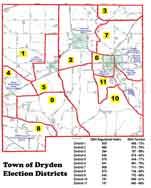Tompkins County Democratic Committee
Last year, at a county committee meeting, someone innocently asked, "What does the Committee do?" Irene Stein, chair of the County committee answered, with aplomb, that the committee identifies and supports candidates for political offices. And that's it. There is some discussion of party platform and strategies to encourage Democrats to register and vote. But no momentous policy decisions are made by the Committee.
Last night's county committee meeting was a vivid example of the process of finding and supporting candidates. We voted unanimously to send Peter Stein and Lori Gardner to the NYS Democratic Committee. We voted unanimously to endorse Elizabeth Garry for NYS Supreme Court in the 6th Judicial District. We endorsed Barbara Lifton for State Assembly with one nay vote. Although the committee usually doesn't endorse candidates at the national level, those of us who live in the 26th congressional district (City and Town of Ithaca and Town of Danby) unanimously endorsed Congressman Hinchey. There was some resistance to endorsing Michael Arcuri for Congress in the 24th district because, tho' he spoke once in Lansing, most of us haven't had a chance to meet or hear him. Still, the endorsement passed with fourteen abstentions.
The passionate debate began when a motion was made to ask Stein and Gardner to withhold support for Senator Clinton at the state committee meeting. A substitute motion was offered to write a letter of concern to Clinton rather than instruct the state delegates. It may seem that withholding support at the state committee meeting makes a more dramatic statement than writing a letter. But Peter Stein pointed out that a delegate saying, "Pass," as the roll is called would go virtually unnoticed. Writing a letter will make a clearer statement. Still, should that statement be made relatively privately to Senator Clinton or somewhat publicly in the state committee?
More important to many committee members is the issue of instructing the state delegates. The committee can express an opinion but cannot require a delegate to vote a certain way. I think this point is too often overlooked at all levels of politics. Try as we might to sway elected officials, we can only express opinions and provide facts and vote. Elected officials are not bound to vote as their constituency wishes. As voters, we study the candidates' positions on important issues to find people whose judgment we trust. We elect them and then their on their own.
I'll write another day about my waning faith in Clinton's judgment. But for now, I appreciate that the committee has let Peter and Lori know how we feel. The discussion was long and heated. The vote was so close, Irene asked supporters of each side to go to opposite sides of the room for an accurate count. Remaining agenda items had to be abandoned because of time constraint. What Peter and Lori and Irene say to the state committee and to Clinton is probably more influential than any single vote. It's local democracy at work and I'm pleased to be a part of it.




